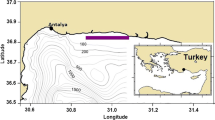Abstract
Parasitic castrators, specifically rhizocephalan barnacles, considered as important regulators of host population density, were proposed as control agents for invasive decapod crustaceans. The temporal variability of the invasive parasitic barnacle Heterosaccus dollfusi prevalence was examined a decade after its introduction into the Mediterranean, with the purpose of elucidating whether it is indeed an efficient control agent of its invasive host, the swimming crab, Charybdis longicollis. Despite the high prevalence of the parasite and its injurious impact on the host reproduction, the Erythrean invasive host-parasite pair reached a modus vivendi with no noticeable reduction in the host population, and high rates of infestation and multiple infestation. It is suggested that high fecundity, “size refuge” formed by parasite-free larger males, and “open” recruitment dynamics, keep the population density of C. longicollis high enough to allow H. dollfusi, with its “closed” recruitment dynamics, to maintain its pandemic infection rates.



Similar content being viewed by others
References
Boschma, H., 1960. A rhizocephalan parasite of the crab Charybdis hoplites (Wood-Mason). Crustaceana 1: 58–67.
Galil, B. S., 1986. Red Sea decapods along the Mediterranean coast of Israel: ecology and distribution. In Dubinsky Z. & Y. Steinberger (eds), Environmental Quality and Ecosystem Stability, Ramat Gan, Bar-Ilan University Press, IIIA/B:179–183.
Galil, B. S., 2000. A sea under siege—alien species in the Mediterranean. Biological Invasions 2: 177–186.
Galil, B. S., 2004. Exotic species in the Mediterranean Sea and pathways of invasion. In Proceedings of a seminar on The Effects of Human Transport on Ecosystems, Royal Irish Academy, 1–14.
Galil, B. S. & J. Lützen, 1995. Biological observations on Heterosaccus dollfusi Boschma (Cirripedia: Rhizocephala), a parasite of Charybdis longicollis Leene (Decapoda: Brachyura), a lessepsian migrant to the Mediterranean. Journal of Crustacean Biology 15: 659–670.
Galil, B. S. & G. Innocenti, 1999. Notes on the population structure of the portunid crab Charybdis longicollis Leene, parasitized by the rhizocephalan Heterosaccus dollfusi Boschma, off the Mediterranean coast of Israel. Bulletin of Marine Science 64: 451–463.
Hawkes, C. R., T. R. Meyers & T. C. Shirley, 1987. Growth of Alaskan blue king crabs, Paralithodes platypus (Brandt), parasitized by the rhizocephalan Briarosaccus callosus Boschma. Crustaceana 52: 78–84.
Hines, A. H., F. Alvarez & S. A. Reed, 1997. Introduced and native populations of a marine parasitic castrator: variation in prevalence of the rhizocephalan Loxothylacus panopaei in xanthid crabs. Bulletin of Marine Science 61: 197–214.
Høeg, J. T. & J. Lützen, 1995. Life cycle and reproduction in the Cirripedia Rhizocephala. Oceanography and Marine Ecology: An Annual Review. 33: 427–485.
Innocenti, G., M. Vannini & B. S. Galil, 1998. Notes on the behaviour of the portunid crab Charybdis longicollis Leene parasitized by the rhizocephalan Heterosaccus dollfusi Boschma. Journal of Natural History 32: 1577–1585.
Innocenti, G., N. Pinter & B. S. Galil, 2003. Observations on the agonistic behavior of the swimming crab Charybdis longicollis Leene infected by the rhizocephalan barnacle Heterosaccus dollfusi Boschma. Canadian Journal of Zoology 81: 173–176.
Kuris, A. M., 1974. Trophic interactions: similarity of parasitic castrators to parasitoids. Quarterly Review of Biology 49: 129–148.
Kuris, A. M., 1997. Conceptual framework for biocontrol of introduced marine pests. In Proceedings of the First International Workshop on the Demography, Impacts and Management of Introduced Populations of the European Crab, Carcinus maenas, Center for Research on Introduced Marine Pests. Technical Report 11: 66–68.
Leene, J. E., 1938. The Decapoda Brachyura of the Siboga-Expedition. VII. Brachygnatha: Portunidae. Siboga Expeditie 39c3: 1–156.
Lewinsohn, Ch. & L. B. Holthuis, 1964. New records of Decapod Crustacea from the Mediterranean coast of Israel and the Eastern Mediterranean. Zoologische Mededelingen, Leiden 40: 45–63.
O‘Brien, J. & P. Van Wyk, 1985. Effects of crustacean parasitic castrators (epicaridean isopods and rhizocephalan barnacles) on the growth of their crustacean hosts. Crustacean Issues 3: 191–218.
Øksnebjerg, B., R. Enzenross & L. Enzenross, 1997. First record of Rhizocephala (Crustacea: cirripedia) from Turkish waters, with notes on Lessepsian migration. Stuttgarter Beiträge zur Naturkunde (Biologie) 557: 1–7.
Ozcan, T., T. Katagan & A. Kocatas, 2005. Brachyuran crabs from Iskenderun Bay (Southeastern Turkey). Crustaceana 78: 237–243.
Phillips, W. J. & L. R. G. Cannon, 1978. Ecological observations on the commercial sand crab, Portunus pelagicus (L.), and its parasite, Sacculina granifera Boschma, 1973 (Cirripedia: Rhizocephala). Journal of Fish Diseases 1: 137–149.
Thresher, R. E., M. Werner, J. T. Høeg, I. Svane, H. Glenner, N. E. Murphy & C. Wittwer, 2000. Developing the options for managing marine pests: specificity trials on the parasitic castrator, Sacculina carcini, against the European crab, Carcinus maenas, and related species. Journal of Experimental Marine Biology and Ecology 254: 37–51.
Torchin, M. E., K. D. Lafferty, A. P. Dobson, J. McKenzie & A. M. Kuris, 2003. Introduced species and their missing parasites. Nature 421: 628–630.
Wolfe, L. M., 2002. Why alien invaders succeed: support for the Escape-from-Enemy Hypothesis. The American Naturalist 160: 705–711.
Acknowledgements
We wish to thank Mel Cooper for his assistance in assembling the Israeli material, and Baki Yokes, for information on the Charybdis-Heterosaccus populations off SE Turkey. Stefano Cannicci provided assistance with statistical analysis. This manuscript was much improved by the comments of Catherine deRivera, Mark Torchin and an anonymous reviewer.
Author information
Authors and Affiliations
Corresponding author
Rights and permissions
About this article
Cite this article
Innocenti, G., Galil, B.S. Modus vivendi: invasive host/parasite relations—Charybdis longicollis Leene, 1938 (Brachyura: Portunidae) and Heterosaccus dollfusi Boschma, 1960 (Rhizocephala: Sacculinidae). Hydrobiologia 590, 95–101 (2007). https://doi.org/10.1007/s10750-007-0761-z
Issue Date:
DOI: https://doi.org/10.1007/s10750-007-0761-z




